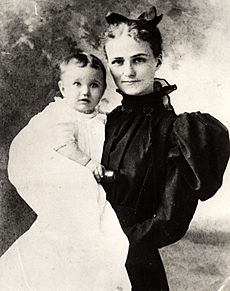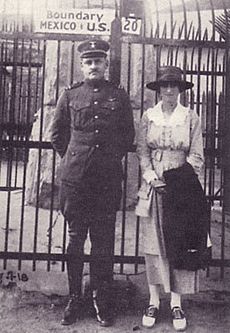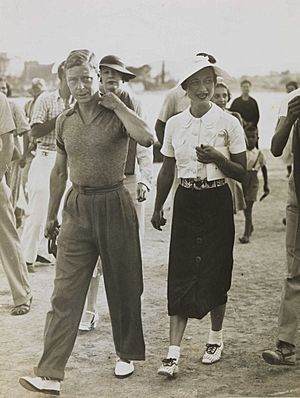Wallis Simpson facts for kids
Quick facts for kids Wallis |
|
|---|---|
| Duchess of Windsor (more) | |
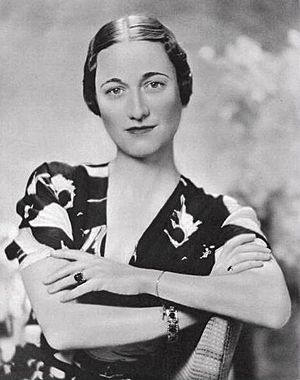
Simpson in 1936
|
|
| Born | Bessie Wallis Warfield June 19, 1896 Square Cottage, Blue Ridge Summit, Pennsylvania, U.S. |
| Died | April 24, 1986 (aged 89) 4 route du Champ d'Entraînement, Paris, France |
| Burial | April 29, 1986 Royal Burial Ground, Frogmore, Berkshire, England |
| Spouse |
Earl Winfield Spencer Jr.
(m. 1916; div. 1927)Ernest Aldrich Simpson
(m. 1928; div. 1937) |
| Father | Teackle Wallis Warfield |
| Mother | Alice Montague |
| Signature |  |
Wallis, Duchess of Windsor (born Bessie Wallis Warfield, later Simpson; June 19, 1896 – April 24, 1986), was an American socialite. She became famous for marrying King Edward VIII of the United Kingdom. Their decision to marry caused a major problem for the government. This led to Edward giving up his throne, an event known as the abdication.
Wallis grew up in Baltimore, Maryland. Her father died when she was very young. She and her mother were helped by wealthier family members. Her first marriage was to a United States Navy officer, Earl Winfield Spencer Jr.. It had many ups and downs and ended in divorce. In 1931, during her second marriage to Ernest Simpson, she met Edward. He was then the Prince of Wales. Five years later, Edward became King of the United Kingdom. Wallis then divorced Ernest to marry Edward.
The King wanted to marry a woman who had two living ex-husbands. This went against the rules of the Church of England. It also caused a big problem for the government in the United Kingdom. This led to Edward giving up his throne in December 1936. He said he wanted to marry "the woman I love." After he gave up the throne, Edward's brother, George VI, made him the Duke of Windsor. Wallis married Edward six months later. She was then known as the Duchess of Windsor. However, she was not allowed to use the title "Royal Highness" like other royal family members.
Before, during, and after World War II, some people thought Wallis and Edward supported the Nazis. In 1937, they visited Germany and met Adolf Hitler. In 1940, Edward became the governor of the Bahamas. The couple lived there until 1945. In the 1950s and 1960s, they lived a relaxed life in Europe and the United States. They were known as society celebrities. After Edward's death in 1972, Wallis lived quietly. She was rarely seen in public. Her life has been much talked about. She is still a debated figure in British history.
Contents
Early Life and Education
Bessie Wallis Warfield was born on June 19, 1896. She was an only child. Her birthplace was Square Cottage at Monterey Inn. This was a hotel in Blue Ridge Summit, Pennsylvania. This area was a summer resort. Many people from Baltimore came there to escape the heat.
Wallis's father was Teackle Wallis Warfield. Her mother was Alice Montague. Wallis was named after her father and her aunt Bessie. She was called Bessie Wallis for some time. Later, she dropped the name Bessie. Her father died in November 1896 from tuberculosis. For her first few years, Wallis and her mother relied on her father's wealthy brother, S. Davies Warfield. He was the postmaster of Baltimore.
In 1902, Wallis and her mother moved in with her aunt Bessie. They lived there for about a year. Later, they moved into their own apartment and then a house. In 1908, Wallis's mother married John Freeman Rasin.
From 1912 to 1914, Wallis attended Oldfields School. This was a very expensive girls' school in Maryland. Her uncle paid for her to go there. She became friends with Renée du Pont and Mary Kirk. A classmate remembered Wallis as very bright. She always dressed well and worked hard. Biographers noted her "fine violet-blue eyes and petite figure." She was also quick-witted and lively.
First Marriage to Earl Spencer
In April 1916, Wallis met Earl Winfield Spencer Jr.. He was a U.S. Navy pilot. She met him in Pensacola, Florida. Wallis saw two airplane crashes around this time. This made her afraid of flying for the rest of her life. They married on November 8, 1916. The wedding was at Christ Episcopal Church in Baltimore.
After the First World War began for the U.S. in 1917, Spencer was sent to San Diego. He was the first commander of a training base there. They stayed in Coronado until 1921.
In 1920, Edward, the Prince of Wales, visited San Diego. However, he and Wallis did not meet then. Later that year, Spencer left Wallis for four months. They reunited in 1921 in Washington, D.C.. Spencer was posted there. They soon separated again. In 1922, Spencer was sent to the Far East. Wallis stayed behind. She visited Paris in January 1924. Then she sailed to the Far East.
The Spencers briefly reunited. But Wallis became ill and returned to Hong Kong. She toured China and stayed with friends, Katherine and Herman Rogers. Wallis spent over a year in China. By September 1925, she and Spencer were back in the U.S. but living apart. Their divorce was final on December 10, 1927.
Second Marriage to Ernest Simpson
After her first marriage ended, Wallis became involved with Ernest Aldrich Simpson. He was an Anglo-American shipping executive. He divorced his first wife to marry Wallis. They married on July 21, 1928, in Chelsea, London. Wallis had accepted his proposal by telegram from Cannes.
The Simpsons lived in a furnished house in Mayfair. In 1929, Wallis visited her sick mother in the U.S. During this trip, Wallis lost her investments in the Wall Street Crash of 1929. Her mother died without money in November 1929. Wallis returned to England. The shipping business was doing well. The Simpsons moved into a large apartment with servants.
Wallis met Thelma, Lady Furness, through a friend. Lady Furness was Edward, Prince of Wales's, girlfriend at the time. On January 10, 1931, Lady Furness introduced Wallis to the Prince. This happened at Burrough Court. The Prince was the eldest son of King George V and Queen Mary. He was the next in line to the British throne. Between 1931 and 1934, Edward met the Simpsons at various parties. Wallis was presented at court. Ernest began to have money problems. The Simpsons were spending too much. They had to let go of some staff.
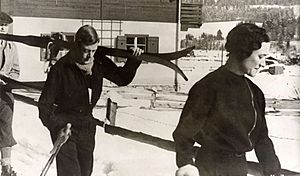
The Abdication Crisis
On January 20, 1936, King George V died. Edward became King Edward VIII. The next day, he broke royal rules. He watched his accession proclamation with Wallis. She was still married at the time. It became clear that the new King wanted to marry her. Edward's actions and his relationship with Wallis made him unpopular. This upset the Conservative government. It also worried his mother and brother. British newspapers did not report on the affair. But foreign media widely covered their relationship.
The King of the United Kingdom is the head of the Church of England. At that time, the Church did not allow divorced people to remarry if their former spouse was still alive. Wallis had divorced twice. This meant his marriage would go against the Church's teachings. Also, her first divorce might have been questioned. This could make her second marriage, and a marriage to Edward, seem invalid.
The British government and other countries in the Dominions felt Wallis was not suitable. They saw a twice-divorced woman as politically, socially, and morally wrong for a queen. Many in the British Empire thought Wallis was very ambitious. They believed she was only interested in the King's wealth and position.
Wallis had already filed for divorce from her second husband. The divorce was approved on October 27, 1936. In November, the King talked to the British Prime Minister, Stanley Baldwin. He wanted to find a way to marry Wallis and keep his throne. Edward suggested a morganatic marriage. This meant he would remain king, but Wallis would not be queen. Baldwin and the prime ministers of Australia, Canada, and South Africa rejected this idea. If Edward married Wallis against Baldwin's advice, the government would have to resign. This would cause a constitutional crisis.
By early December, Wallis's relationship with Edward was public in the UK. She decided to leave the country. She drove to the south of France to avoid the press. For three months, she was surrounded by media. She stayed at the Villa Lou Viei, with her friends Herman and Katherine Rogers. The King's aide, Lord Brownlow, pressured her to give up Edward. On December 7, 1936, Brownlow read Wallis's statement to the press. It said she was ready to give up Edward. However, Edward was determined to marry her. His lawyer said Edward felt he had no choice but to give up the throne.
Edward signed the Instrument of Abdication on December 10, 1936. His three brothers were present. Special laws were passed by the parliaments of the Dominions. These laws finalized Edward's abdication the next day. His brother, the Duke of York, became King George VI. On December 11, Edward spoke on the radio. He said he could not do his duties as King without the help of "the woman I love."
Edward left Britain for Austria. He stayed with friends there. He had to stay away from Wallis. This was to make sure her divorce was finalized without problems. Her divorce became final in May 1937. She changed her name back to Wallis Warfield. The couple reunited at the Château de Candé, France, on May 4, 1937.
Third Marriage: Duchess of Windsor
Wallis and Edward married one month later, on June 3, 1937. The wedding was at the Château de Candé. French millionaire Charles Bedaux lent it to them. The date was King George V's 72nd birthday. Queen Mary thought this was done on purpose to be disrespectful. No one from Edward's family attended. Wallis wore a "Wallis blue" Mainbocher wedding dress. Edward gave her an engagement ring. It had an emerald and diamonds. The words "We are ours now" were engraved on it. The Church of England did not approve the wedding. But a vicar, Robert Anderson Jardine, performed the service. The marriage did not produce any children. In November, Ernest Simpson married Mary Kirk.
Edward was made Duke of Windsor by his brother King George VI. This happened before the marriage. However, a special document from the new king prevented Wallis from using the title "Royal Highness". George VI, Queen Mary, and Queen Elizabeth (later the Queen Mother) all agreed on this. At first, the British royal family did not accept Wallis. They would not officially meet her. Some people believe Queen Elizabeth disliked Wallis. They thought it was because Wallis's actions led to George VI becoming king. This might have contributed to his early death. However, Elizabeth's friends denied this. They said she never spoke badly of the Duchess of Windsor. Wallis resented not getting the royal title. She also disliked that Edward's family did not accept her.
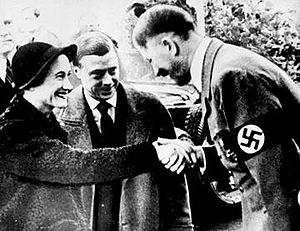
Wallis and Edward lived in France before the war. In 1937, they made a well-known visit to Germany. They met Adolf Hitler at his home, the Berghof. After the visit, Hitler reportedly said Wallis "would have made a good queen." This visit made many people in government suspect Wallis was a German agent. She found this idea ridiculous. U.S. FBI files from the 1930s also suggested she might have supported the Nazis.
Edward wrote in the New York Daily News in 1966. He said Hitler made him think that Russia was the only enemy. He believed it was good for Britain and Europe if Germany attacked Russia. Edward admitted Hitler fooled him. He thought other countries could stay neutral while the Nazis and Russians fought.
Second World War Years
As German troops advanced, the Windsors left their Paris home. They went south to Biarritz, then to Spain in June. Wallis told the U.S. ambassador that France lost because it was "internally diseased." The couple moved to Portugal in July. They stayed in Cascais at a banker's home. This banker was suspected of being a German agent.
In August 1940, the Duke and Duchess traveled to the Bahamas. Edward became governor there. Wallis did her job well as the governor's wife for five years. She worked for the Red Cross and helped improve infant care. However, she hated Nassau. She called it "our St Helena", referring to where Napoleon was exiled. The British press criticized her for her expensive shopping in the U.S. This was happening while Britain faced rationing and blackouts. Prime Minister Winston Churchill strongly objected in 1941. This was when the couple planned to tour the Caribbean on a yacht. The yacht belonged to a Swedish businessman. Churchill said he was "pro-German." Churchill also complained when the Duke gave a "defeatist" interview. The British government did not trust Wallis. After Nazi Germany was defeated, the couple returned to France.
Later Life and Widowhood
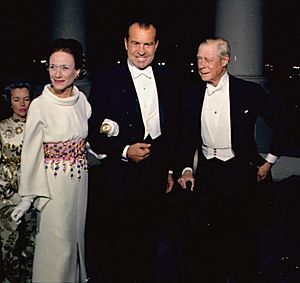
In 1946, some of Wallis's jewels were stolen. There were rumors that the theft was planned by the royal family. They wanted to get back jewels taken from the Royal Collection. Or, some thought the Windsors themselves planned it for insurance money. However, in 1960, a criminal confessed to the crime. The stolen pieces were only a small part of the Windsor jewels. Most were bought privately or inherited by the Duke.
In 1952, the Paris city government offered the Windsors a house. The couple lived at 4 route du Champ d'Entraînement in the Bois de Boulogne. They lived there for most of their remaining lives. They enjoyed an easy retirement. They often traveled between Europe and America by ocean liners. They bought a second house in the countryside. It was called Moulin de la Tuilerie. They became close friends with their neighbors, Oswald and Diana Mosley.
In 1965, the Duke and Duchess visited London. Edward needed eye surgery. His niece, Queen Elizabeth II, and sister-in-law, Princess Marina, Duchess of Kent, visited them. Edward's sister, the Princess Royal, also visited them shortly before her death. Wallis and Edward attended her memorial service. Later, in 1967, they joined the royal family in London. This was for the unveiling of a plaque. It marked 100 years since Queen Mary's birth. The couple gave a BBC television interview in 1970. Both Queen Elizabeth II and her son Charles, Prince of Wales, visited the Windsors in Paris. This was in Edward's final years.
Upon Edward's death from throat cancer in 1972, Wallis traveled to the United Kingdom. She attended his funeral. She stayed at Buckingham Palace. Wallis became very frail and developed dementia. She lived her final years as a recluse. She was supported by her husband's estate and money from the Queen. She fell several times and broke her hip twice.
In 1980, Wallis lost her ability to speak. Towards the end, she was bedridden. She did not receive visitors, except her doctor and nurses.
Death and Burial
Wallis died on April 24, 1986, at her home in Paris. She was 89 years old. Her funeral was held on April 29 at St George's Chapel, Windsor Castle. Her two surviving sisters-in-law attended. Other royal family members were also there. The Queen, the Duke of Edinburgh, and the Prince and Princess of Wales attended. The Princess of Wales later said it was the only time she saw the Queen cry.
Wallis was buried next to Edward. This was in the Royal Burial Ground near Windsor Castle. Her grave is marked "Wallis, Duchess of Windsor." Before an agreement with Queen Elizabeth II in the 1960s, Wallis and Edward planned to be buried in Baltimore. This was where Wallis's father was buried.
Wallis's collection of Louis XVI style furniture, some porcelain, and paintings were given to the French state. This was in thanks for France providing them a home. The British royal family did not receive many items. Most of her estate went to the Pasteur Institute. This is a medical research foundation. This decision surprised the royal family and Wallis's friends. She had shown little interest in charity during her life.
In 1987, Wallis's jewelry collection was auctioned. It raised $45 million for the institute. This was about seven times more than expected. An auction of other items from her estate was held in 1998. It raised over £14 million for charity.
Legacy and Impact
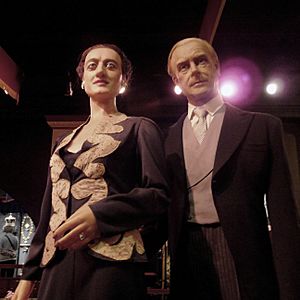
Wallis's memoir, The Heart Has Its Reasons, was published in 1956. Biographers have said that facts were often changed in it. She has been described as "charismatic, electric and compulsively ambitious."
Wallis's life has been surrounded by rumors and guesses. Her own changes to the truth did not help. But, according to her biographers, there is no clear proof that she was anything more than a victim of her own ambition. She lived a great romance that turned into a tragedy. One biographer wrote that she "experienced the ultimate fairy tale." She became the adored favorite of the most glamorous bachelor of her time. But the dream went wrong. He gave up his position to spend his life with her, even though she asked him not to. Wallis herself reportedly said, "You have no idea how hard it is to live out a great romance."
Titles and Styles
- June 19, 1896 – November 8, 1916: Miss Bessie Wallis Warfield
- November 8, 1916 – July 21, 1928: Mrs. Earl Winfield Spencer Jr.
- July 21, 1928 – May 7, 1937: Mrs. Ernest Aldrich Simpson
- May 7, 1937 – June 3, 1937: Mrs. Wallis Warfield
- Wallis started using her maiden name again on May 7, 1937. But she still used the title "Mrs."
- June 3, 1937 – April 24, 1986: Her Grace The Duchess of Windsor
- The Duchess of Windsor was unofficially called Her Royal Highness by those close to her.
See also
 In Spanish: Wallis Simpson para niños
In Spanish: Wallis Simpson para niños


